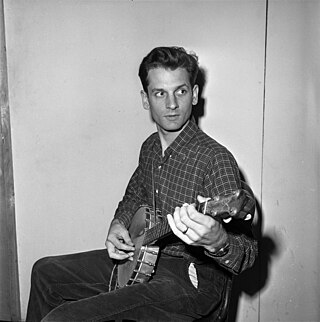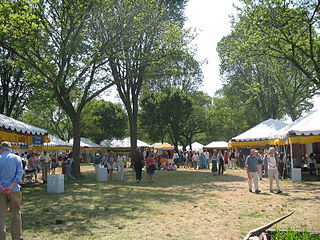Smithsonian career
Kurin worked on contract as a program manager for the Smithsonian's Festival of American Folklife for the U.S. Bicentennial in 1976. He conducted research for the Smithsonian in India and Pakistan from the late 1970s through the mid-1980s, and served as the program manager for the Smithsonian's Festival of India in 1984–85. [2] He worked closely with Smithsonian Secretary S. Dillon Ripley, Ralph Rinzler and Jeffrey Lariche and Indian designer Rajeev Sethi in organizing Aditi: A Celebration of Life, a major exhibition of the traditional Indian life cycle that included scores of musicians and artisans in the National Museum of Natural History, and curating Mela: An Indian Fair for the Festival of American Folklife outdoors on the National Mall in Washington, D.C. [8] He became deputy director of the Smithsonian's Office of Folklife Programs in 1985, then its acting director in 1988.
In 1990 he was appointed director of the Center for Folklife and Cultural Heritage by Secretary Robert McCormack Adams, a position he held until 2009. [1] As director, he was responsible for the Smithsonian Folklife Festival on the National Mall, Smithsonian Folkways Recordings, and other cultural educational programs. [8] [9] Kurin, working with festival director Diana Parker and Center deputy director Richard Kennedy, arranged for dozens of programs at the festival, among the highlights a program on Massachusetts in 1988, Hawaii in 1989, White House workers, Maroon and New Mexico programs in 1992, Iowa in 1996, Wisconsin in 1998, the Mississippi Delta in 1999, Tibetan culture with the Dalai Lama in 2000, New York City in 2001, and the Silk Road with Yo-Yo Ma and more than 500 other artists from 28 countries in 2002 supported by funds from the Aga Khan Trust for Culture. He worked closely with Samuel Sidibe of Mali for the 2003 Festival; Haitian colleagues Geri Benoit, Patrick Delatour, Patrick Villaire and Olsen Jean Julian from Haiti for the 2004 Festival; cultural leaders in Northern Ireland in 2007; and Jigme Thinley, who became the first Prime Minister of Bhutan, for the 2008 Festival. [8] [9] [10]
In 1987 Kurin worked with Ralph Rinzler on the acquisition of Folkways from Moses Asch and family. [11] This included the production of a benefit album to raise funds for the acquisition. The album Folkways: A Vision Shared featured Bob Dylan, Bruce Springsteen, U2 and others. [12] Produced by Columbia Records with Don Devito and Harold Levanthal, it won a Grammy Award for best traditional folk album.
Kurin worked with fellow anthropologist Tony Seeger as the first director of Smithsonian Folkways Recordings and enlisted Grateful Dead drummer and musicologist Mickey Hart to re-engineer the collection. [9] Smithsonian Folkways went on to produce more than a dozen Grammy winning and nominated albums, including the Anthology of American Folk Song in 1997. [13]
He garnered grants from the Rockefeller Foundation and the Paul Allen Foundation with John Kertzer to start Smithsonian Global Sounds, a digital music archive and distribution service. [14]
Kurin continued to work with musicians like Yo-Yo Ma and Mickey Hart on other several other recording and educational projects. [15]
Dorothy Height, the president of the National Council of Negro Women, enlisted Kurin to help organize the production of the first National Black Family Reunion on the National Mall in 1986. [9] Aid continued for over two decades.
Kurin produced many of the Smithsonian's major public programs on the National Mall, such as the Smithsonian's Birthday Party in 1996, the National World War II Reunion for the opening of the National World War II Memorial, and the opening of the National Museum of the American Indian, both in 2004. [8] [16] [17] Kurin produced public programs for Presidential Inaugurals in 1993, 1997, 2005, 2009, and 2013. [1] [8] He worked with the Atlanta Committee for the Olympic Games to produce a cultural festival in Centennial Park during the games in 1996, and with the White House to produce public programs for the celebration of the Millennium at the end of 1999. [1] [8]
Kurin was awarded the Smithsonian Secretary's Gold Medal for Exceptional Service in 1996. [1]
Kurin, with support from the U.S. Department of State, was appointed by the Director-General of UNESCO to a distinguished international jury for the Masterpieces of Oral and Intangible Heritage program in 1999. [18] In the same year, Kurin organized an international conference on Safeguarding Traditional Cultures with UNESCO at the Smithsonian. [19] Kurin advised the U.S. Department of State on the development of an international treaty concerning traditional cultural heritage, and participated in an international experts group to help draft the Convention for the Safeguarding of Intangible Cultural Heritage which was approved by UNESCO in 2003 and has been ratified by more than 160 nations. [20] [21] Kurin led Smithsonian efforts to make the institution a Rockefeller Foundation Humanities Fellowship program site for three years for a project on theorizing cultural heritage. [22] Kurin was appointed by Secretary of State Colin Powell to the U.S. Commission for UNESCO in 2005 and reappointed by Secretary of State Condoleezza Rice in 2006. [23] Kurin serves as the Smithsonian liaison to the White House Historical Association and the President's Committee for the Arts and the Humanities. [2]
While director of the Smithsonian Center for Folklife and Cultural Heritage, Kurin was appointed chair of the Smithsonian's 150th anniversary program committee by Secretary I. Michael Heyman. [8] In 2004, Kurin was appointed acting director of Smithsonian National Programs by Secretary Lawrence Small, and two years later, director, overseeing the Smithsonian Institution Traveling Exhibition Service, The Smithsonian Associates, Smithsonian Affiliates and other educational programs as well as the programmatic aspects of the Smithsonian Channel, a cable television partnership with Showtime. [1] [24] In 2007, acting Secretary Cristian Samper appointed Kurin the Smithsonian's acting Under Secretary for History and Culture, responsible for oversight of the National Museum of American History, National Museum of the American Indian, National Museum of African American History and Culture, National Postal Museum, Anacostia Community Museum, Center for Folklife and Cultural Heritage, Smithsonian Latino Center and Asian Pacific American Program. [1] Several months later, art was added to Kurin's portfolio as he took on oversight of the Smithsonian American Art Museum, National Portrait Gallery, Freer and Sackler Galleries of Art, Hirshhorn Museum & Sculpture Garden, Cooper-Hewitt National Design Museum, National Museum of African Art, and Archives of American Art. In 2009, Secretary G. Wayne Clough made the appointment permanent. [1] In addition to overseeing museums and programs, Kurin shares responsibilities for the Smithsonian's Libraries, Archives, Fellowships, Collections and International Programs with the Under Secretary for Science. In 2009, Kurin organized the Smithsonian 2.0 conference, pairing Smithsonian staff with leaders in web and digital media from academic, educational and business worlds. [25]
In 2010, Kurin founded and organized the Haiti Cultural Recovery Project with the U.S. President's Committee for the Arts and the Humanities and other cultural organizations to help save that nation's heritage after the devastating earthquake. Funded by U.S.AID, The Broadway League, and other sponsors, the project sent more than 80 conservators to Haiti, trained more than 150 Haitians and saved some 35,000 artworks, artifacts, murals, sculptures, rare books and archives. [26] Kurin later joined with colleagues to develop and support an advanced internship for Haitian conservators at Yale University, and with the Ben Stiller Foundation to establish and build a Cultural Conservation Center at Quisqueya University in Port-au-Prince in 2015. With Cultural Preservation Officer Cori Wegener, [27] Kurin led Smithsonian efforts to save cultural heritage endangered by terrorism in Mali, Egypt, Iraq and Syria, and that threatened by natural disaster in the wake of Superstorm Sandy in New York and the 2015 earthquake in Nepal.
In 2015, David Skorton became Secretary of the Smithsonian and with the approval of the Board of Regents, the White House, and then Congress in 2016, reorganized its senior management, instituting the position of Provost. Kurin was appointed Acting Provost and Under Secretary for Museums, continuing to oversee all of the History, Art, and Culture museums and programs, but subsuming those formerly overseen by the Under Secretary for Science. Kurin became responsible for the National Air and Space Museum and its Stephen-Udvar Hazy Center, National Museum of Natural History, National Zoological Park and its Smithsonian Conservation Biology Institute, Smithsonian Astrophysical Observatory, Smithsonian Environmental Research Center, and Smithsonian Tropical Research Institute. He also assumed oversight of the Office of Fellowships & Internships, Museum Conservation Institute, National Collections Program, Smithsonian Institution Archives, Smithsonian Institution Libraries, and Smithsonian Scholarly Press.

Mike Seeger was an American folk musician and folklorist. He was a distinctive singer and an accomplished musician who mainly played autoharp, banjo, fiddle, dulcimer, guitar, harmonica, mandolin, dobro, jaw harp, and pan pipes. Seeger, a half-brother of Pete Seeger, produced more than 30 documentary recordings, and performed in more than 40 other recordings. He desired to make known the caretakers of culture that inspired and taught him. He was posthumously inducted into the International Bluegrass Music Hall of Fame in 2018.
Public folklore is the term for the work done by folklorists in public settings in the United States and Canada outside of universities and colleges, such as arts councils, museums, folklife festivals, radio stations, etc., as opposed to academic folklore, which is done within universities and colleges. The term is short for "public sector folklore" and was first used by members of the American Folklore Society in the early 1970s.

Cultural heritage is the heritage of tangible and intangible heritage assets of a group or society that is inherited from past generations. Not all heritages of past generations are "heritage"; rather, heritage is a product of selection by society.
Smithsonian Folkways is the nonprofit record label of the Smithsonian Institution. It is a part of the Smithsonian's Smithsonian Center for Folklife and Cultural Heritage, located at Capital Gallery in downtown Washington, D.C. The label was founded in 1987 after the family of Moses Asch, founder of Folkways Records, donated the entire Folkways Records label to the Smithsonian. The donation was made on the condition that the Institution continue Asch's policy that each of the more than 2,000 albums of Folkways Records remain in print forever, regardless of sales. Since then, the label has expanded on Asch's vision of documenting the sounds of the world, adding six other record labels to the collection, as well as releasing over 300 new recordings. Some well-known artists have contributed to the Smithsonian Folkways collection, including Pete Seeger, Ella Jenkins, Woody Guthrie, and Lead Belly. Famous songs include "This Land Is Your Land", "Goodnight, Irene", and "Midnight Special". Due to the unique nature of its recordings, which include an extensive collection of traditional American music, children's music, and international music, Smithsonian Folkways has become an important collection to the musical community, especially to ethnomusicologists, who utilize the recordings of "people's music" from all over the world.
The Center for Folklife & Cultural Heritage (CFCH) is one of three cultural centers within the Smithsonian Institution in the United States. Its motto is "culture of, by, and for the people", and it aims to encourage understanding and cultural sustainability through research, education, and community engagement. The CFCH contains (numerically) the largest collection in the Smithsonian, but is not fully open to the public. Its budget comes primarily from grants, trust monies, federal government appropriations, and gifts, with a small percentage coming from the main Smithsonian budget.
In social science, foodways are the cultural, social, and economic practices relating to the production and consumption of food. Foodways often refers to the intersection of food in culture, traditions, and history.

The Smithsonian Folklife Festival, launched in 1967, is an international exhibition of living cultural heritage presented annually in the summer in Washington, D.C. in the United States. It is held on the National Mall for two weeks around the Fourth of July holiday. The Smithsonian Center for Folklife and Cultural Heritage produces the Festival.

Smithsonian Libraries and Archives is an institutional archives and library system comprising 21 branch libraries serving the various Smithsonian Institution museums and research centers. The Libraries and Archives serve Smithsonian Institution staff as well as the scholarly community and general public with information and reference support. Its collections number nearly 3 million volumes including 50,000 rare books and manuscripts.

Folkways Records was a record label founded by Moses Asch that documented folk, world, and children's music. It was acquired by the Smithsonian Institution in 1987 and is now part of Smithsonian Folkways.

The Convention for the Safeguarding of the Intangible Cultural Heritage is a UNESCO treaty adopted by the UNESCO General Conference on 17 October 2003.

Nicholas R. Spitzer is an American radio personality and folklorist.
Barbara Kirshenblatt-Gimblett is a scholar of Performance and Jewish Studies and a museum professional. Professor Emerita of Performance Studies at New York University, she is best known for her interdisciplinary contributions to Jewish studies and to the theory and history of museums, tourism, and heritage. She is currently the Ronald S. Lauder Chief Curator of the Core Exhibition and Advisor to the Director at POLIN Museum of the History of Polish Jews in Warsaw.
Roland L. Freeman was an American photographer and documenter of Southern folk culture and African-American quilters. He was the president of The Group for Cultural Documentation, founded in 1991 and based in Washington, D.C.
Michael Atwood Mason is an American folklorist and museum professional. He was CEO and Executive Director of President Lincoln's Cottage. Up to February 2021 he was the Director of the Smithsonian Center for Folklife and Cultural Heritage.
Museum folklore is a domain of scholarship and professional practice within the field of folklore studies (folkloristics).
Victoriano Arizapana Huayhua is a Quechua master rope bridge engineer, notable for being the lead builder of the Q'iswa Chaka, which is the last remaining traditionally built Inca rope bridge and a part of the historical Qhapaq Ñan Inca road network. He is also a teacher and cultural figure, preserving and transmitting to future generations the bridgebuilding techniques passed to him by his ancestors.
Intangible cultural heritage are elements of the cultural heritage of Georgia which are abstract and must be learned, encompassing traditional knowledge including festivals, music, performances, celebrations, handicrafts, and oral traditions.
Sabrina Lynn Motley is the director of the Smithsonian Folklife Festival at the Center for Folklife and Cultural Heritage. She was formerly senior director of programs and exhibitions at Asia Society Texas Center.
The Mother Tongue Film Festival is an annual international film festival of films with lesser-used languages from around the world. It is organized by the Smithsonian Institution in Washington, D.C., and has been held to coincide with International Mother Tongue Day on 21 February each year since 2016.
C. Kurt Dewhurst is an American curator and folklorist. Dewhurst is Director for Arts and Cultural Partnerships at Michigan State University (MSU) and also a Senior Fellow in University Outreach and Engagement. At MSU, he is also Director Emeritus of the Michigan State University Museum and a Professor of English and Museum Studies.







